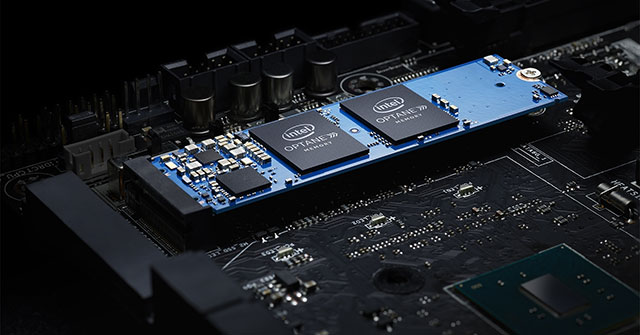Intel officially introduced Optane memory
Since Intel and Micron introduced 3D XPoint storage technology in 2015, the world has expected them to use it to produce new memory.
3D XPoint has both the properties of flash memory and DRAM. Like flash, it has durability, holds data even when the system is turned off and has a density of 10 times more than DRAM. Like DRAM, it supports low latency. Intel also said that it has a better number of write times (write endurance rate) than flash memory.
Combining these will produce memory that looks like DIMM, the system recognizes as DDR4 RAM, but has a large capacity, high durability: the data written to RAM is stored permanently. Such memory is very attractive with a wide range of applicability, such as databases that do not need to be concerned about transferring data to the drive, one day can make changes in the design of OS and software.
Although durable memory is the most notable application of 3D XPoint, the first product to market is just a conventional storage drive, named Optane. These are storage drives for businesses, and for individual users, it is only dedicated M.2 cards that come with a spinning disk to create a high-speed hybrid.
It is true that 3D XPoint has some advantages compared to flash SSDs, such as ultra-low latency, heavy I / O operation and read / write volume, this is not what we expected.
Today Intel announced Intel Optane DC Persistent Memory, DDR4 memory (128GB, 256GB and 512GB capacities) uses 3D XPoint instead of traditional DRAM cells. Latency is worse than DDR4 but the cards are more durable. Although using the DDR4 standard, it only supports Intel's Xeon CPU.

Memory combines many possibilities from both flash and DRAM
Intel is trying to use new memory to increase the amount of memory available for processors, reducing latency that often occurs when transferring data from memory to storage devices. This is useful for workloads like databases or caching.
The durability here means that the new server reboots without loading TB data into memory, all of which are already in it. Durable memory has a lot of impact on software developers so Intel also plans to help them remotely access Optane Persistent Memory for development, software testing that exploits the benefits of this feature.
In addition to the basic information, there are many things we do not know about Optane DC Persistent Memory: operability, durability, power consumption, system / microprocessor compatibility . Intel also did not specify when Which product launches. Maybe they will be widely released in 2019 but there will be users selected to experience early this year.
See more:
- Learn about Intel's new Optane memory
- Memory and storage 3D What is NAND?
- Leaked online information about Intel Core i7-8086K 5Ghz Anniversary Edition processor
You should read it
- Windows 10 May 2020 Update encountered an incompatibility error with Intel Optane memory
- Intel brought its strongest chip, a Core i9 processor, to a laptop
- The company has created an SD memory card that can store data on par with the hard drive you are using
- Top 3 best memory card format software
- Buy genuine memory cards, cheap where Hanoi & Ho Chi Minh City?
- Nano memory card memory card, solution for smartphones not equipped with memory card slot
 Leaked online information about Intel Core i7-8086K 5Ghz Anniversary Edition processor
Leaked online information about Intel Core i7-8086K 5Ghz Anniversary Edition processor Thanks to the Snapdragon 710 chip, there's no need to spend $ 1000 to buy a phone
Thanks to the Snapdragon 710 chip, there's no need to spend $ 1000 to buy a phone What is RCS? Will it replace SMS in the future?
What is RCS? Will it replace SMS in the future? Microsoft will soon have a 12TB virtual machine
Microsoft will soon have a 12TB virtual machine Windows 10 finally has a remarkable screen capture tool
Windows 10 finally has a remarkable screen capture tool Microsoft's new Windows 10 application helps to screen the phone screen on a PC
Microsoft's new Windows 10 application helps to screen the phone screen on a PC